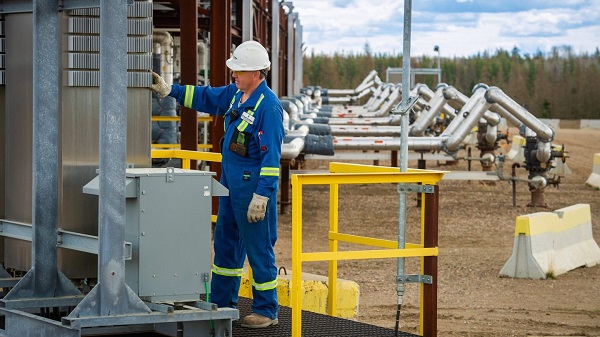Alberta
Garfield Marks; “Oil-by-Seaway” proposal still draws interest.

The proposal to by-pass Quebec in shipping oil to refineries in New Brunswick via Thunder Bay then shipping through the St. Lawrence Seaway still has legs.
Nov 9 2019, Comments by D.B. Chalcroft on the
PROPOSAL TO SHIP OIL TO EASTERN CANADA VIA ST. LAWRENCE SEAWAY by Garfield Marks
Garfield Marks published his “Oil-by-Seaway” and it has subsequently been covered in the CBC media and more recently on CHQR 770 radio.
The Garfield Marks “Oil-by-Seaway” Proposal
Concept – To replace the eastern half (about 2600 km) of the proposed Energy East Pipeline with tanker shipping from Thunder Bay via the Great Lakes and the St. Lawrence Seaway to St. John, New Brunswick.
The Energy East pipeline proposed by TC Energy in 2014, would have converted about 3000 km of the existing natural gas pipeline from Hardisty, Alberta to the Ontario-Quebec border, to diluted bitumen transportation; and would have built 1600 kms of new pipeline from the Ontario-Quebec border to St. John, New Brunswick. The capacity of the pipeline was to have been 1.1 million barrels (200,000 tonnes) of crude oil per day, was estimated to cost $12 billion, and at 4600 km would have been the longest pipeline in North America. TC Energy subsequently cancelled the project in October 2017, citing regulatory rule changes. In addition the Government of Quebec has stated that there is no social license for the Energy East pipeline through Quebec.
“Oil-by-Seaway” Tanker Shipping Option
The “Oil-by-Seaway” proposal would include converting 2000 km of the existing TC Energy Natural Gas pipeline from Hardisty, Ab, to Thunder Bay to carry diluted bitumen, and creating a new oil tanker shipping system from Thunder Bay through the existing St Lawrence Seaway and by ocean to the major Irving oil refinery at St. John , NB.
The existing St. Lawrence Seaway has more available shipping capacity than is presently being utilized. During the 1970s and 1980s, cargo shipments from Thunder Bay, for example, averaged about 20,000,000 metric tonnes per year with between 850 and 1470 vessels per year leaving the port. Since 2009 cargo shipments from Thunder Bay have averaged only about 8,000,000 tonnes/year on some 400 vessels per year.
The existing locks in the St. Lawrence Seaway at the Welland Canal and near Montreal, impose length, width, and draft, size restrictions (maximums of 225.5 m long by 23.8 m wide and draft of 8 m) on the vessels that can use the Great Lakes shipping system. The maximum size of bulk cargo that can be shipped through the system is about 29,000 tonnes per Seaway-capable ship – these ships are known as “lakers”.
The St Lawrence Seaway averages about 275 days of navigation per year – the other 90 days being closed to shipping due to winter conditions.
In order for “Oil-by-Seaway” shipping to deliver the 1,100,000 BPD (200,000 tonnes per day) of oil to the St John, NB terminal as envisaged by Energy East, in a shipping season of 275 days, would require the daily shipping deliveries to be 265,000 tonnes/day during the navigation season. This would require close to 10 “laker-tankers” per day to unload at St. John, NB. Assuming the turn-around time for a “laker-tanker” from Thunder Bay to St. John to Thunder Bay is about 16 days including 2 days for loading and unloading – means that a fleet of about 160 “laker-tankers” would be required to achieve this delivery commitment, plus storage facilities at St John of about 100,000,000 barrels.
The Welland Canal currently has about 1500-1800 vessel transits each way per year, or on average 5-7 transits per day each way. However in 1960 the total number of vessel transits was as high as 4500 each way (an average of 16 /day) although vessels were smaller carrying an average of only 3,400 tonnes of cargo. The Oil-by-Seaway proposal would add 2700 passages per year bringing the total to around 4500 per year or 16 per day each way, very similar to the 1960 record rate albeit with larger average vessel sizes.
Ballpark Cost Estimate for 160 Laker-Tankers
What would it cost to create a fleet of say 160 “Laker-tankers”? As a very rough comparison, the three Newfoundland Off-shore Shuttle Tankers that pickup roughly 230,000 BPD (47,000 tonne/day) of oil production from the five producing platforms on the Grand Banks, cost a reported $375,000,000 (ie $125M/ship)in 2016, and have a deadweight of 148,000 tonnes and gross tonnage of 85,000 tonnes each, meaning each ship can carry up to about 60,000 tonnes of cargo (oil) . These three Shuttle Tankers deliver the 47,000 tonne/day of Grand Bank oil production to the trans-shipment terminal at Whiffen Head, NL with an average turn-around time of 3-5 days . A rough cost estimate for the Laker-Tankers can be obtained by taking $125M X 29,000 t/ 60,000 t = $60 million. Therefore the cost of one “Laker-tanker” with 29,000 tonne capacity is estimated to be in the order of $60 million, and a fleet of 160 Laker-tankers would be in the ballpark of $10 billion.
Discussion
The St. Lawrence Seaway is currently handling 20-25 million tonnes of cargo per year through the Welland Canal in the Downbound direction, ie towards the east, with total transits of 1400 – 1900 per year. Oil-by-Seaway to equal the Energy East proposal of 200,000 tonnes per day would add 73,000,000 tonnes/yr. to the Downbound traffic. This is a significant increase to nearly 100,000,000 tonnes/year and 16 vessel transits per day each way, through the Seaway System. It would appear that the present Seaway infrastructure may be able to accommodate this magnitude of increase without major upgrades, because it doesn’t exceed the historical highs in vessel transits which occurred in the 1960s. This would need to be confirmed with the St. Lawrence Seaway Management Corporation.
The Oil-by-Seaway proposal would require a fleet of 160 or so “Laker-Tankers” which most likely don’t currently exist, and which would cost in the order of $10 billion . This concept would also require the creation of about 100,000,000 bbl. of incremental oil storage capacity at St. John, NB, that probably wasn’t part of the Energy East proposal, to cover the 90 days each year when the Seaway is closed.
Utilizing the existing Seaway Infrastructure to transport oil by tanker would reverse a long trend of declining commodity traffic through the Seaway system. This scheme could create the impetus to update and modernize Seaway facilities, and could also reinvigorate the communities along the Seaway, with substantially more economic activity in their midst.
Fabricating 160 Laker-Tankers could provide a significant workload for Canada’s ship-building industry, perhaps including the Davie Shipyard in Quebec, and the Irving shipyard in Halifax.
There are undoubtedly many other technical, social, environmental, and regulatory issues to be identified and considered, as well as whether this concept is commercially viable.
Preliminary Conclusion
On the surface, the Garfield Marks “Oil-by-Seaway” proposal seems to have sufficient merit to warrant a more thorough analysis than presented herein.
Comments by: David B. Chalcroft, P. Eng.
Previously published;
We have not been able to run our bitumen through a pipeline to a refinery in New Brunswick. There has been resistance in parts of Ontario and in Quebec. What if we came up with another plan. Would we consider it? There will be road blocks, but not insurmountable, would we consider it?
Yes how about Thunder Bay?
Thunder Bay, Ontario, the largest Canadian port of the St. Lawrence Seaway located on the west end of Lake Superior, 1850 kms. from Hardisty, Alberta. A forgotten jewel.
So what, you may ask.
They used to ship grain from Thunder Bay in huge tankers to ports all over the world. Why not oil?
The Saint Lawrence Seaway ships fuel, gasoline and diesel tankers, to this day.
We could run oil tankers to the Irving refinery in New Brunswick, bypassing the controversial pipeline running through eastern Ontario and Quebec.
The pipeline, if that was the transport model chosen, would only need to run through parts of Alberta, Saskatchewan, Manitoba and Ontario. Like, previously stated the pipeline would only be 1850 kms. long.
The other great thing about Thunder Bay is the abundance of rail lines. Transportation for such things as grain and forestry products from western Canada. If you can’t run pipeline from Hardisty, through to Thunder Bay, use the railroad.
Why Hardisty, you may ask.
Hardisty, according to Wikipedia, is mainly known as a pivotal petroleum industry hub where petroleum products such as Western Canada Select blended crude oil and Hardisty heavy oil are produced, stored and traded.
The Town of Hardisty owes its very existence to the Canadian Pacific Railway. About 1904 the surveyors began to survey the railroad from the east and decided to locate a divisional point at Hardisty because of the good water supply from the river.
Hardisty, Alberta has the railroad and has the product, the storage capacity, and the former Alberta government planned on investing $3.7 billion in rail cars for hauling oil while Thunder Bay has the railroad and an under utilised port at the head of the St. Lawrence Seaway.
Economics are there along with opportunity, employment would be created and the east coast could end its’ dependency on imported oil.
Do we have the vision or willingness to consider another option. I am just asking for all avenues to be considered.
In my interviews in Ontario there is a willingness to discuss this idea.
The St. Lawrence Seaway Management Corporation is still reviewing the idea of shipping crude oil from western Canada through its system, and it’s a long way from happening, according to Bruce Hodgson, the Seaway’s director of market development.
“Obviously, there needs to be an ongoing commitment on the part of a producer, and so that’s going to be required for any project of this nature,” he said.
We could consider it, could we not?
CBC NEWS did a story about this idea on March 7 2019;
A retired oil field worker in Alberta has “floated” a novel solution to Alberta’s oil transportation woes: pipe the bitumen to Thunder Bay, Ont., then ship it up the St. Lawrence Seaway to the Irving oil refinery in New Brunswick.
Marks’ proposal might be more than a pipe dream, according to the director of the Queen’s Institute for Energy and Environmental Policy.
‘I don’t think that it’s a totally nuts idea’
“I don’t think that it’s a totally nuts idea,” Warren Mabee said. “I think that there’s some flaws to it … but this is an idea that could work in certain circumstances and at certain times of year. … It’s not the craziest thing I’ve ever heard.”
The chief executive officer of the Port of Thunder Bay said shipping oil from the port “could easily be done.”
“We ship refined gasoline and diesel up from Sarnia. We’ve done that for many many years,” Tim Heney told CBC. “So it’s not something that’s that far-fetched.”
There are, however, plenty of potential drawbacks to shipping crude through the Seaway, Mabee explained, not least of which is the fact that it isn’t open year-round.
The need to store oil or redirect it during the winter months could be costly, he said.
Potential roadblocks
Another potential pitfall is capacity, he added; there may not be enough of the right-sized tankers available to carry the oil through the Seaway.
Finally, he said, the journey by sea from Lake Superior to the Irving refinery in New Brunswick is a long one, so it might make more sense to transport the product to a closer facility such as the one in Sarnia, Ont.
The St. Lawrence Seaway Management Corporation is still reviewing the idea of shipping crude oil from western Canada through its system, and it’s a long way from happening, according to Bruce Hodgson, the Seaway’s director of market development.
“Obviously, there needs to be an ongoing commitment on the part of a producer, and so that’s going to be required for any project of this nature,” he said.
So far, no producer has come forward seeking to ship crude through Thunder Bay, he said.
Asked about the possible environmental risks of shipping oil on Lake Superior, both Hodgson and Heney said shipping by tanker is relatively safe; Hodgson noted that any tankers carrying the product would have to be double-hulled, and crews are heavily vetted.
Time to rethink pipelines?
There hasn’t been a spill in the Seaway system for more than 20 years he said.
Nonetheless, Mabee said, the potential for an oil spill on the Great Lakes could be a huge issue.
“The St. Lawrence and the Great Lakes have a lot of people living in close proximity, a lot of people who rely on it for drinking water,” he said. “There’s a delicate ecosystem there. I think a lot of people would push back against this proposal simply from that perspective.”

In fact, one of the reasons Mabee appreciates Marks’ proposal, he said, is because it invites people to weigh the pros and cons of different methods of transporting oil.
“If we’re not going to build pipelines, but we’re going to continue to use oil, it means that people are going to be looking at some of these alternative transport options,” he said.
“And if we don’t want oil on those alternative transport options, we need to give the pipelines another thought.
Time to consider all options, I dare say.
Alberta
Alberta government’s plan will improve access to MRIs and CT scans

From the Fraser Institute
By Nadeem Esmail and Tegan Hill
The Smith government may soon allow Albertans to privately purchase diagnostic screening and testing services, prompting familiar cries from defenders of the status quo. But in reality, this change, which the government plans to propose in the legislature in the coming months, would simply give Albertans an option already available to patients in every other developed country with universal health care.
It’s important for Albertans and indeed all Canadians to understand the unique nature of our health-care system. In every one of the 30 other developed countries with universal health care, patients are free to seek care on their own terms with their own resources when the universal system is unwilling or unable to satisfy their needs. Whether to access care with shorter wait times and a more rapid return to full health, to access more personalized services or meet a personal health need, or to access new advances in medical technology. But not in Canada.
That prohibition has not served Albertans well. Despite being one of the highest-spending provinces in one of the most expensive universal health-care systems in the developed world, Albertans endure some of the longest wait times for health care and some of the worst availability of advanced diagnostic and medical technologies including MRI machines and CT scanners.
Introducing new medical technologies is a costly endeavour, which requires money and the actual equipment, but also the proficiency, knowledge and expertise to use it properly. By allowing Albertans to privately purchase diagnostic screening and testing services, the Smith government would encourage private providers to make these technologies available and develop the requisite knowledge.
Obviously, these new providers would improve access to these services for all Alberta patients—first for those willing to pay for them, and then for patients in the public system. In other words, adding providers to the health-care system expands the supply of these services, which will reduce wait times for everyone, not just those using private clinics. And relief can’t come soon enough. In Alberta, in 2024 the median wait time for a CT scan was 12 weeks and 24 weeks for an MRI.
Greater access and shorter wait times will also benefit Albertans concerned about their future health or preventative care. When these Albertans can quickly access a private provider, their appointments may lead to the early discovery of medical problems. Early detection can improve health outcomes and reduce the amount of public health-care resources these Albertans may ultimately use in the future. And that means more resources available for all other patients, to the benefit of all Albertans including those unable to access the private option.
Opponents of this approach argue that it’s a move towards two-tier health care, which will drain resources from the public system, or that this is “American-style” health care. But these arguments ignore that private alternatives benefit all patients in universal health-care systems in the rest of the developed world. For example, Switzerland, Germany, the Netherlands and Australia all have higher-performing universal systems that provide more timely care because of—not despite—the private options available to patients.
In reality, the Smith government’s plan to allow Albertans to privately purchase diagnostic screening and testing services is a small step in the right direction to reduce wait times and improve health-care access in the province. In fact, the proposal doesn’t go far enough—the government should allow Albertans to purchase physician appointments and surgeries privately, too. Hopefully the Smith government continues to reform the province’s health-care system, despite ill-informed objections, with all patients in mind.
Alberta
Canada’s heavy oil finds new fans as global demand rises

From the Canadian Energy Centre
By Will Gibson
“The refining industry wants heavy oil. We are actually in a shortage of heavy oil globally right now, and you can see that in the prices”
Once priced at a steep discount to its lighter, sweeter counterparts, Canadian oil has earned growing admiration—and market share—among new customers in Asia.
Canada’s oil exports are primarily “heavy” oil from the Alberta oil sands, compared to oil from more conventional “light” plays like the Permian Basin in the U.S.
One way to think of it is that heavy oil is thick and does not flow easily, while light oil is thin and flows freely, like fudge compared to apple juice.
“The refining industry wants heavy oil. We are actually in a shortage of heavy oil globally right now, and you can see that in the prices,” said Susan Bell, senior vice-president of downstream research with Rystad Energy.
A narrowing price gap
Alberta’s heavy oil producers generally receive a lower price than light oil producers, partly a result of different crude quality but mainly because of the cost of transportation, according to S&P Global.
The “differential” between Western Canadian Select (WCS) and West Texas Intermediate (WTI) blew out to nearly US$50 per barrel in 2018 because of pipeline bottlenecks, forcing Alberta to step in and cut production.
So far this year, the differential has narrowed to as little as US$10 per barrel, averaging around US$12, according to GLJ Petroleum Consultants.
“The differential between WCS and WTI is the narrowest I’ve seen in three decades working in the industry,” Bell said.
Trans Mountain Expansion opens the door to Asia

Oil tanker docked at the Westridge Marine Terminal in Burnaby, B.C. Photo courtesy Trans Mountain Corporation
The price boost is thanks to the Trans Mountain expansion, which opened a new gateway to Asia in May 2024 by nearly tripling the pipeline’s capacity.
This helps fill the supply void left by other major regions that export heavy oil – Venezuela and Mexico – where production is declining or unsteady.
Canadian oil exports outside the United States reached a record 525,000 barrels per day in July 2025, the latest month of data available from the Canada Energy Regulator.
China leads Asian buyers since the expansion went into service, along with Japan, Brunei and Singapore, Bloomberg reports. 
Asian refineries see opportunity in heavy oil
“What we are seeing now is a lot of refineries in the Asian market have been exposed long enough to WCS and now are comfortable with taking on regular shipments,” Bell said.
Kevin Birn, chief analyst for Canadian oil markets at S&P Global, said rising demand for heavier crude in Asia comes from refineries expanding capacity to process it and capture more value from lower-cost feedstocks.
“They’ve invested in capital improvements on the front end to convert heavier oils into more valuable refined products,” said Birn, who also heads S&P’s Center of Emissions Excellence.
Refiners in the U.S. Gulf Coast and Midwest made similar investments over the past 40 years to capitalize on supply from Latin America and the oil sands, he said.
While oil sands output has grown, supplies from Latin America have declined.
Mexico’s state oil company, Pemex, reports it produced roughly 1.6 million barrels per day in the second quarter of 2025, a steep drop from 2.3 million in 2015 and 2.6 million in 2010.
Meanwhile, Venezuela’s oil production, which was nearly 2.9 million barrels per day in 2010, was just 965,000 barrels per day this September, according to OPEC.
The case for more Canadian pipelines

Worker at an oil sands SAGD processing facility in northern Alberta. Photo courtesy Strathcona Resources
“The growth in heavy demand, and decline of other sources of heavy supply has contributed to a tighter market for heavy oil and narrower spreads,” Birn said.
Even the International Energy Agency, known for its bearish projections of future oil demand, sees rising global use of extra-heavy oil through 2050.
The chief impediments to Canada building new pipelines to meet the demand are political rather than market-based, said both Bell and Birn.
“There is absolutely a business case for a second pipeline to tidewater,” Bell said.
“The challenge is other hurdles limiting the growth in the industry, including legislation such as the tanker ban or the oil and gas emissions cap.”
A strategic choice for Canada
Because Alberta’s oil sands will continue a steady, reliable and low-cost supply of heavy oil into the future, Birn said policymakers and Canadians have options.
“Canada needs to ask itself whether to continue to expand pipeline capacity south to the United States or to access global markets itself, which would bring more competition for its products.”
-

 Crime2 days ago
Crime2 days agoPublic Execution of Anti-Cartel Mayor in Michoacán Prompts U.S. Offer to Intervene Against Cartels
-

 Environment2 days ago
Environment2 days agoThe era of Climate Change Alarmism is over
-

 Justice2 days ago
Justice2 days agoA Justice System That Hates Punishment Can’t Protect the Innocent
-

 Aristotle Foundation2 days ago
Aristotle Foundation2 days agoB.C. government laid groundwork for turning private property into Aboriginal land
-

 Business24 hours ago
Business24 hours agoCarney government should retire misleading ‘G7’ talking point on economic growth
-

 Alberta1 day ago
Alberta1 day agoCanada’s heavy oil finds new fans as global demand rises
-

 Daily Caller1 day ago
Daily Caller1 day agoNigeria Would Welcome US Intervention In Massacre Of Christians By Islamic Terror Groups
-

 Automotive1 day ago
Automotive1 day agoCanada’s EV experiment has FAILED








